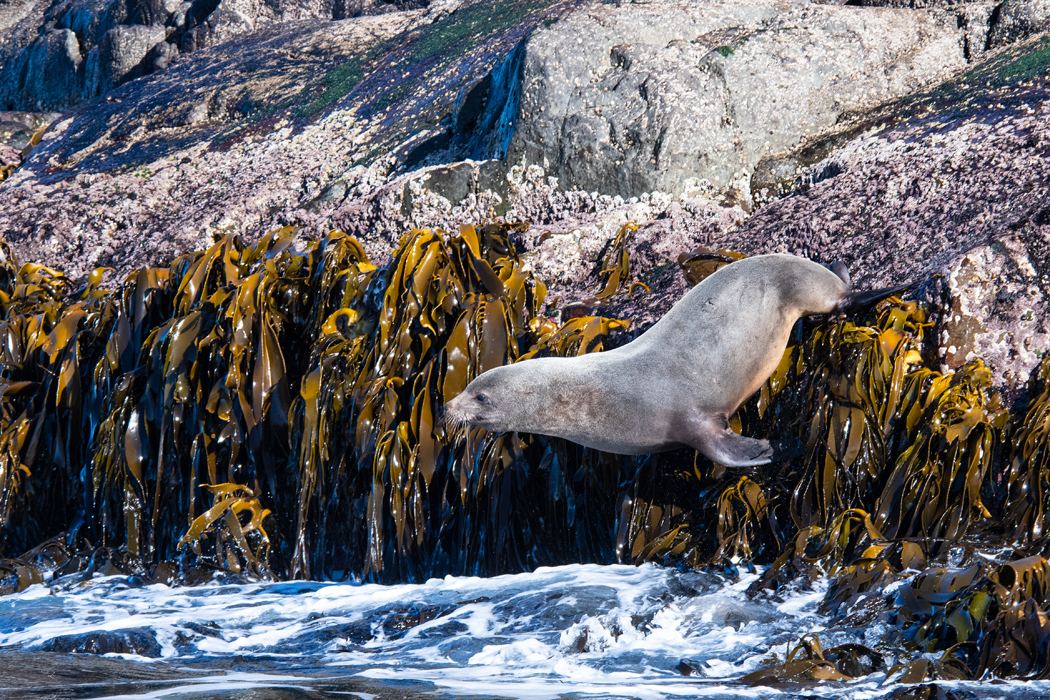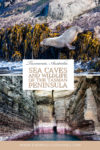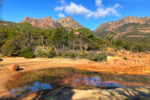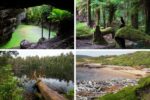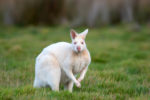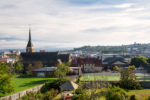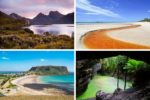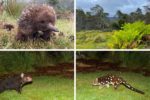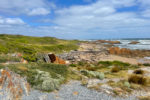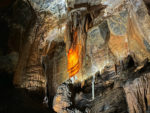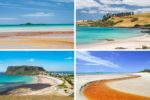Wild and remote, Tasman Peninsula has one of the most dramatic coastlines in Australia. And for a continent literally surrounded by stunning coastlines, it is saying a lot. But while most Australian coastlines are beautiful in an inviting kind of way, Tasman Peninsula’s beauty is strikingly harsh.
Here, 250-meter-high straight hexagonal dolerite columns rise out of the turbulent waters of the Southern Ocean to meet the onslaught of the roaring forties – the strong westerly winds that ravage the latitudes 40 degrees south of the Earth’s equatorial plane.
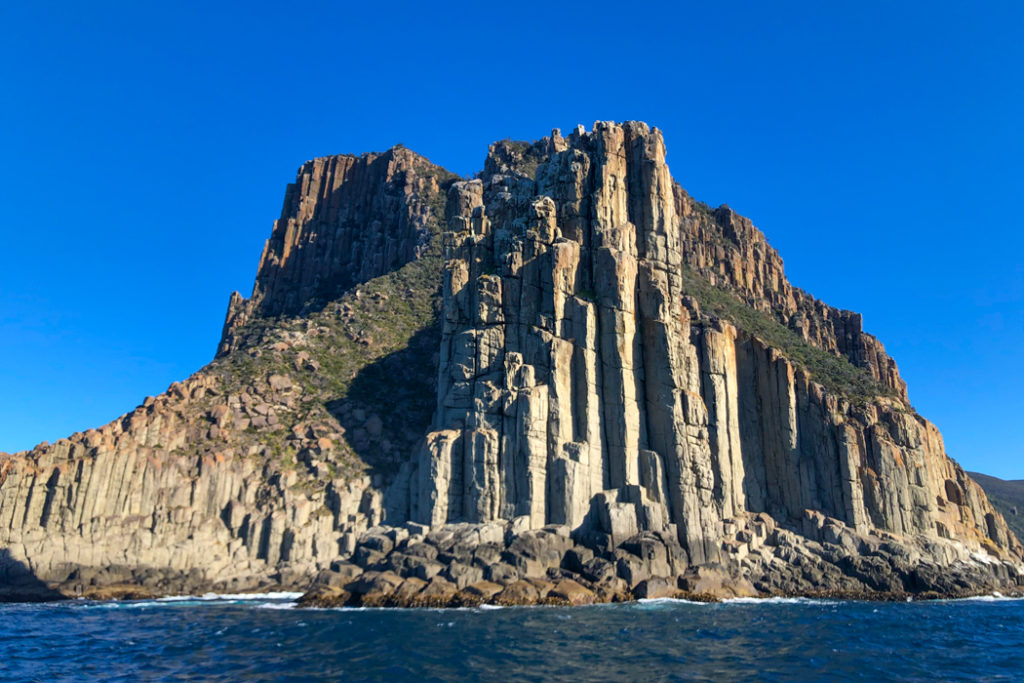
Yet despite the roaring winds and massive swells, many creatures make this stark landscape their home – seals, dolphins and whales thrive in the nutrient-rich waters. Sea birds come to breed here in their thousands and eagles soar on the thermal currents. The most adventurous way to explore the Tasman Peninsula is on a 3-hour Tasman Island Cruise with Pennicott Wilderness Journeys.
Departing Hobart
Our day tour with Pennicott starts with a 7.30 am pick up in Hobart. It’s late May and the pre-dawn temperature is about 6 degrees Centigrade. As I walk to Pennicott’s office at Franklin Wharf, the sky is coming to life with multiple shades of reds and purples in a spectacular winter sunrise.
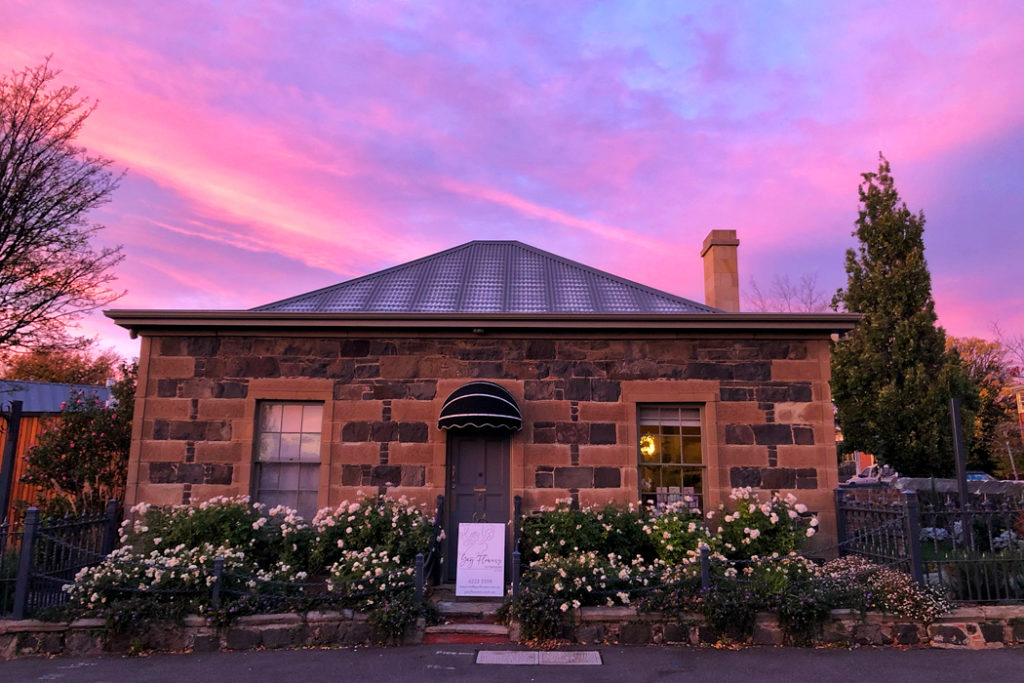
It’s about a 1.5hr drive from Hobart to Port Arthur where we will jump on board a speed boat for the cruise. To be honest, I am a little concerned about freezing solid on the boat, especially when I notice frost on the grass when we stop at Rosedale Homestead for a coffee break. Phil, our driver, chuckles approvingly when he sees me pulling out a beanie, a scarf, and a pair of fleece gloves from my bag, in anticipation of our maritime adventure.
Tasman Island Cruise
When we arrive at Pennicott Wilderness Journeys office, next door to the (in)famous Port Author historic prison, each of us is given a rolled-up bundle that on closer inspection turns out to be a full-length waterproof poncho. Now properly equipped for the ride, we follow Lily, our guide for the cruise, to the jetty where we meet the skipper and receive our briefing. Every seat on the boat is the best seat. The front end will get the bumpiest ride and most of the sea spray, the back end is the calmest.
“I want to sit at the front. We don’t have to sit together” says the guy in front of me to his girlfriend who is nervously clutching a pair of binoculars to her chest. Birdwatchers – my kind of people.
“You’ve got to be kidding” she responds in disbelief, echoing my thoughts.
Yet when we get into the boat, I find myself walking forward and taking a seat in front of them, only because the front two seats are already taken. What the hell, if you are going on an adventure, may as well go all in.
The thick poncho and four layers of wool, fleece, and goose down give me a sense of security for the speedy run through the turbulent sea. That and the safety belt that every seat is equipped with to prevent you from getting thrown out of your seat!
Cruising Ladies Bay
We are exceptionally lucky with the weather – it is unseasonably warm and the swells are gentle enough for the full cruise around the peninsula from Ladies Bay to Eaglehawk Neck in Pirate Bay. In stormier seas, the cruises leave from and return to Eaglehawk Neck only exploring the eastern coastline of the peninsula. I am starting to feel a little overdressed as we start cruising through the bay and stop to check out the ruins of Port Author prison.
Our first wildlife sighting is a colony of Black-faced cormorants – the only true marine cormorants, sunbaking on the coastal cliffs. And even here, in the calm waters of the bay, I find photography quite challenging. The rocking of the boat makes it tough to keep the birds in the frame long enough to fire off a few shots. Once we are out in the Tasman Sea, photography will become an extreme sport.
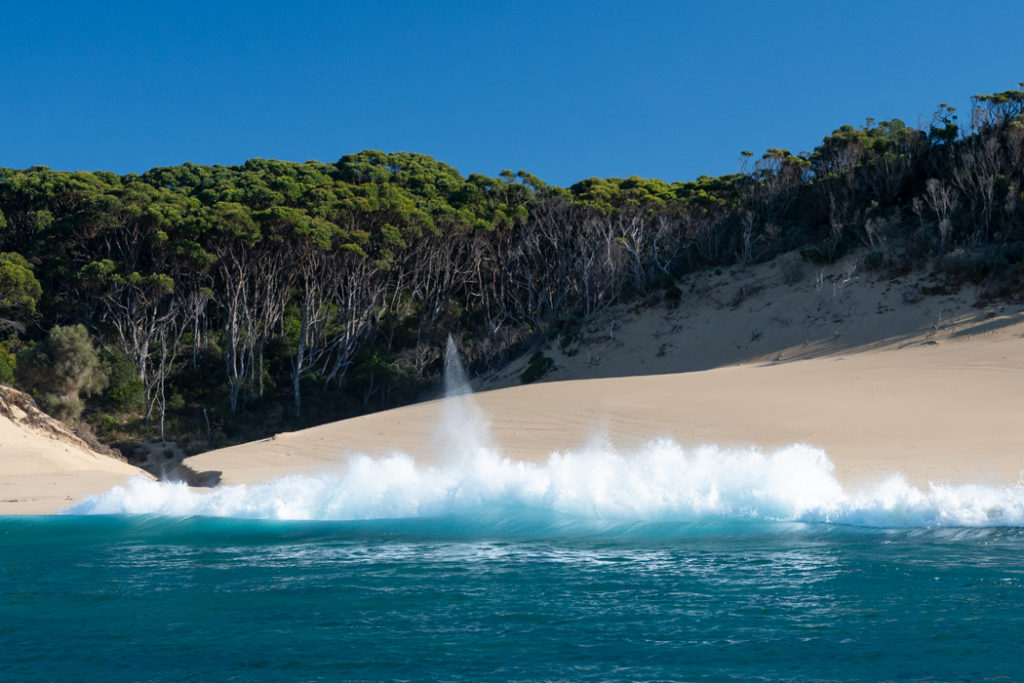
Near the mouth of the bay, we duck into a smaller Crescent Bay to check out a stunning wild sandy beach. Large coastal dunes slope sharply to the ocean to create a very secluded spot. It’s about a 1hr walk from Pennicott’s office to this beach – a fun adventure for anyone staying in the area.
Black Shore
Once we are out of the bay, the skipper revs the engine and sets course along the rugged coastline of the peninsula. Much of the peninsula is protected as 107.5-square-kilometre Tasman National Park, home to the popular four-day Three Capes Track. Some of the geological features we’ll see from the boat can also be explored from land, like the Tasman Arch and Hell’s Kitchen, as well as some amazing caves.
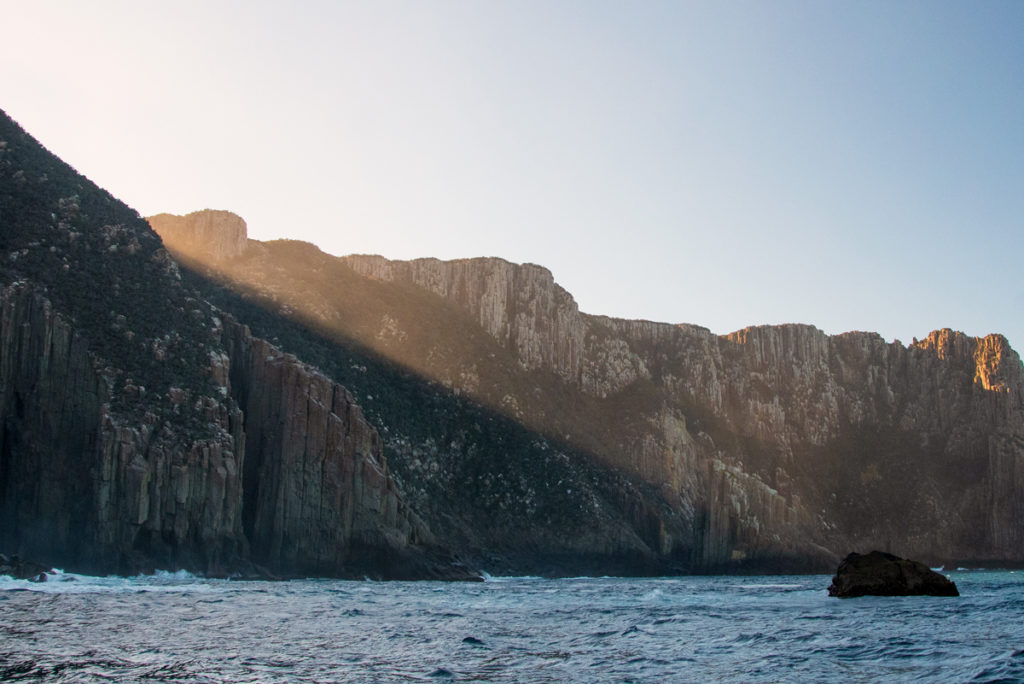
Our journey towards the southern-most point of Tasman Peninsular where Tasman Island is located starts along the Black shore an area of coastal cliffs between the Black Head and Tasman Island that never get touched by the rays of the sun. As hard as the sunlight tries to filter over the soaring dolerite columns, it never quite makes it to the lower parts. Despite the sunny weather and the clear blue sky, these massive cliff faces remain dark and uninviting.
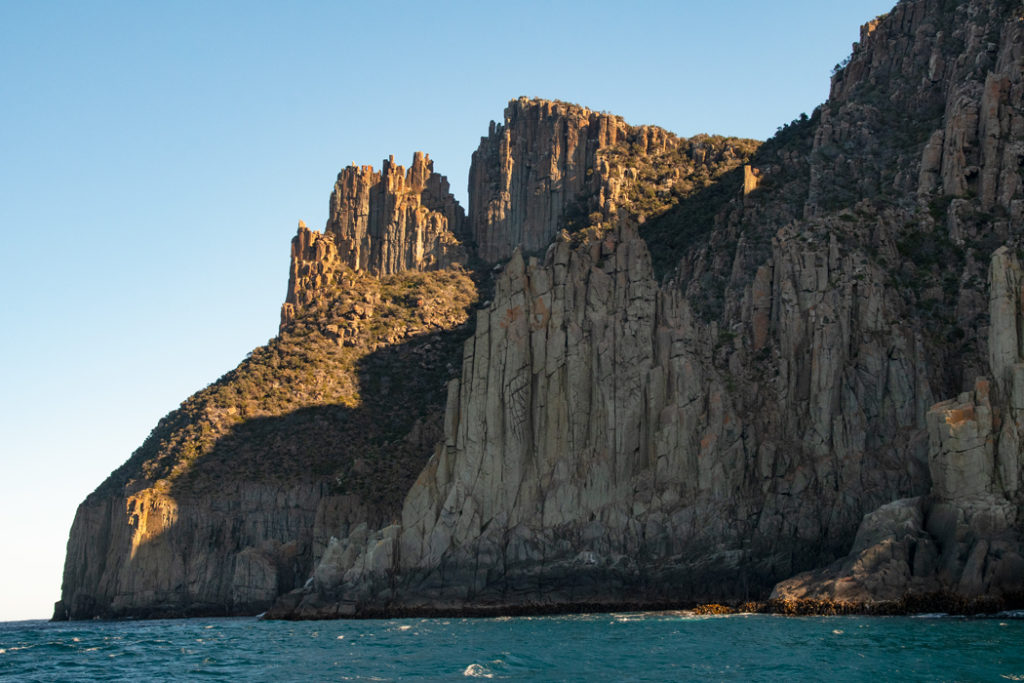
The massive hexagonal rock columns that dominate the coastline of the Tasman Peninsula (and much of Tasmania) not only look unexpected, they are quite a rare phenomenon. They are made up of dolerite – a type of dark, fine-grained rock that formed underground during the Jurassic period (185 million years ago) when the ancient supercontinent Gondwana broke up and vast quantities of molten rock (magma) were pushed up from deep within the earth. Magma cooled near the surface, but it took millions of years of erosion before it became visible above ground.
I’ve seen similar hexagonal columns at Sawn Rocks and Warrumbungles in NSW, and while those columns are composed of a different type of rock, they look just as alien. As far as dolerite columns go, they are quite rare and Tassie is home to most of them.
Tasman Island
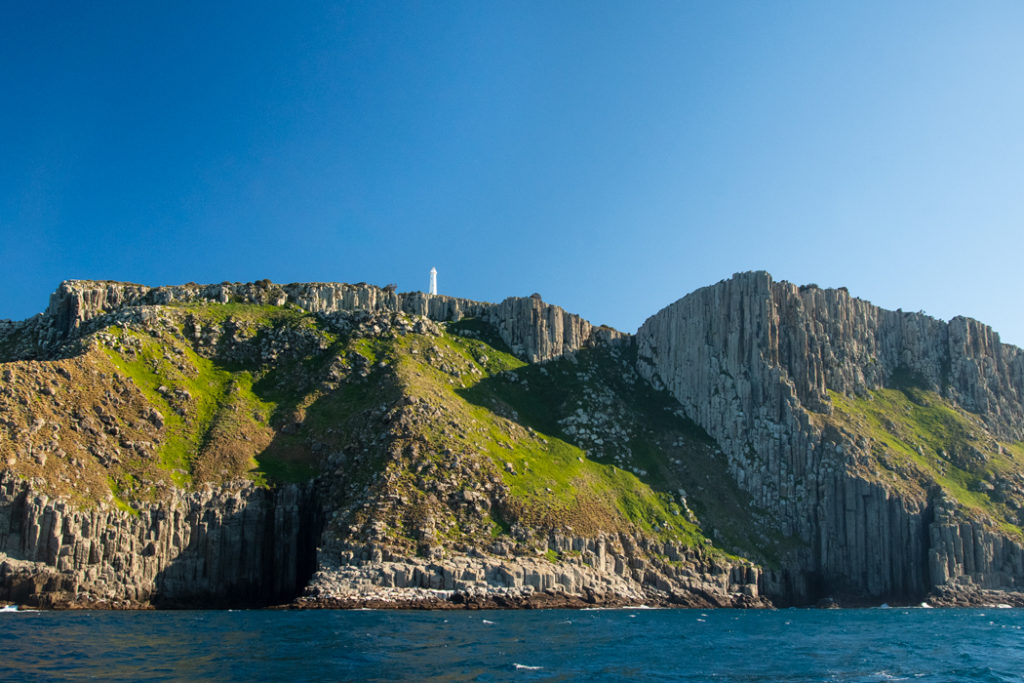
Tasman island rises 240 meters straight out of the sea on forbidding vertical cliffs. The 50-ha plateau above is a flat, treeless, windswept place that is virtually inaccessible today unless you have a helicopter. Yet this is where the Consolidated Marine Board decided to build a lighthouse in 1906. It would seem that almost any other place on the Tasmanian coastline would’ve been an easier spot for a construction project. Not only did the rough seas prevented access to the island, but the gale-force winds that frequently blow at this latitude also kept damaging the infrastructure that was built.
At times, the winds were so strong that the Lighthouse keeper and his family members had to tie themselves down with ropes if they needed to move between buildings.
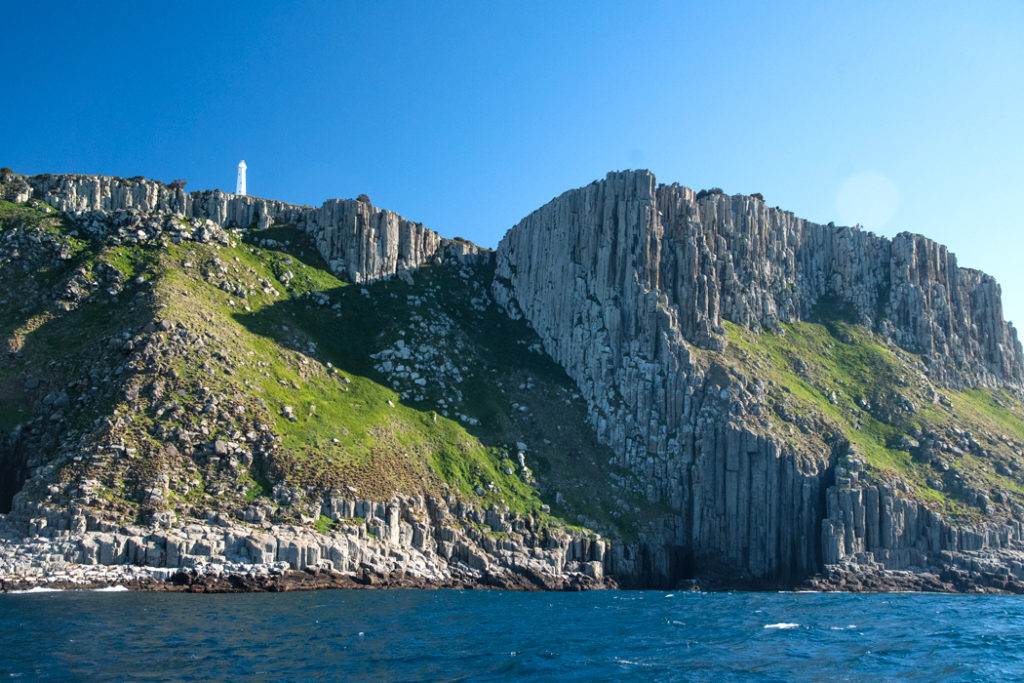
But while Tasman Island is quite uninviting for humans, it is very popular with local wildlife. The Continental Shelf runs close to the island and an upwelling of nutrients from the ocean’s depths attracts a wide variety of marine wildlife.
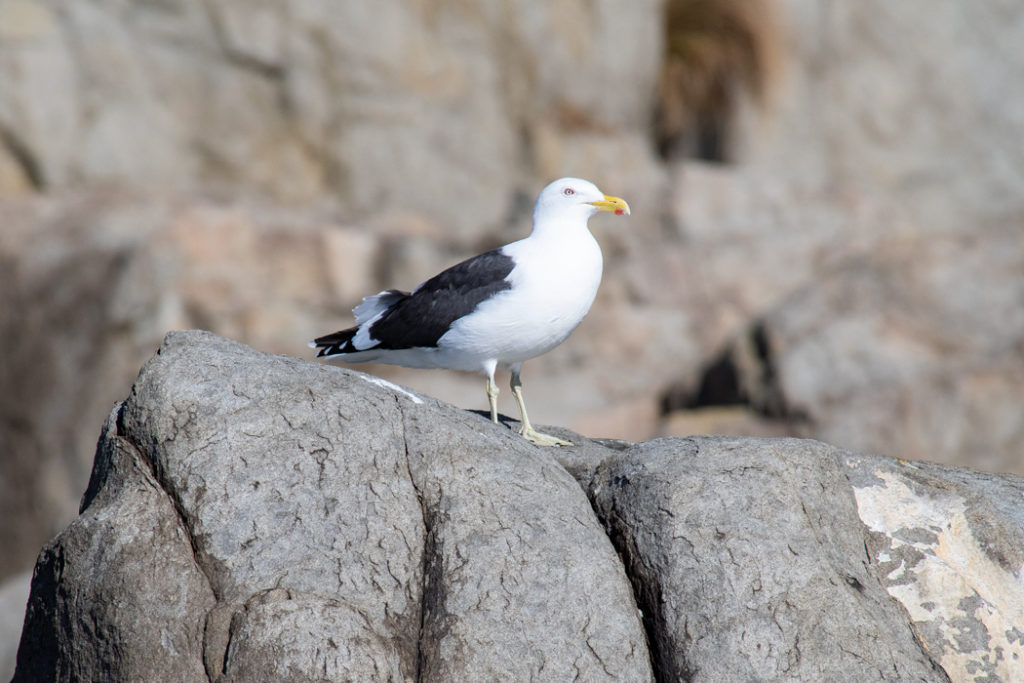
Tasman Island is home to 300,000-700,000 pairs of Fairy penguins, which is probably the largest colony in Australia. Australian and Long-nosed fur seals use the island’s rocky shores as haul-out sites, dolphins and Humpback whales often visit the surrounding waters and millions of Short-tailed Shearwaters come here between September and April. If you had a chance to see the Sheerwaters return to their burrows at dusk on Bruny Island, here you can witness a feeding frenzy when hundreds of birds are hunting at the same time.
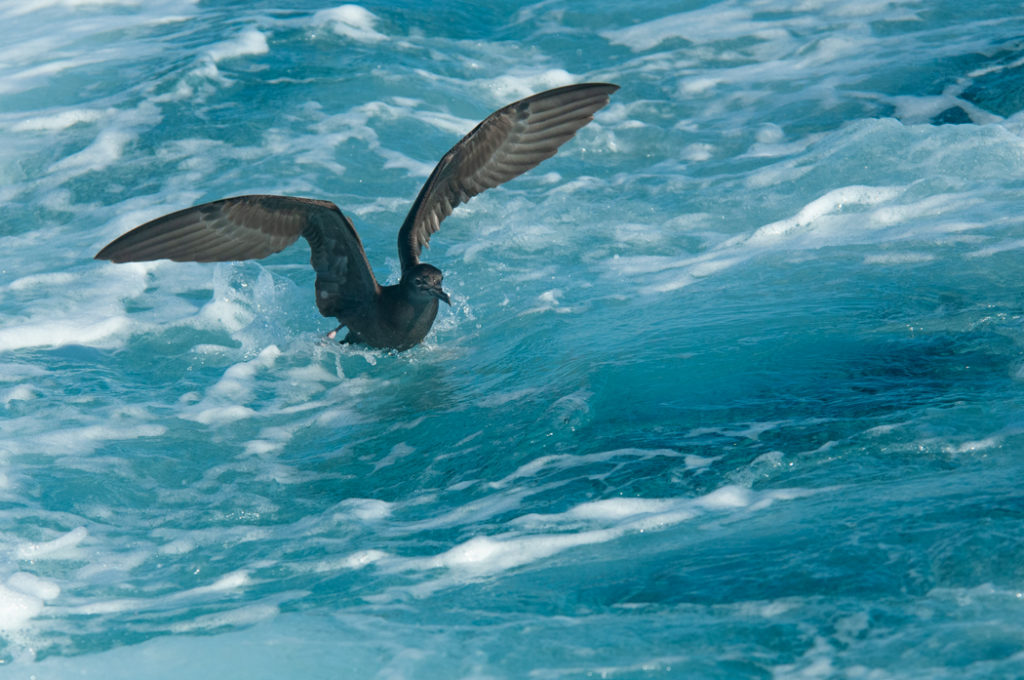
Although in May, there are only a few shearwaters around. Mainly the young that were left behind. Short-tailed shearwaters have an unusual breeding strategy. They come to Tasmania in late September-October to mate and lay their eggs. The parents incubate the eggs and feed the hatchlings until they are weaned. So far so good. But once the hatchlings are weaned, adults take to the wing and start their journey back to their feeding grounds in Alaska, leaving the semi-adult chicks behind.
Juvenile sheerwaters are left to fend for themselves as they put on enough weight for the long journey north. Of course, historically, the most dangerous predators for the chick were humans. Thankfully, today muttonbird harvesting is regulated and most of the licenses are issued to the indigenous communities.
Once the chicks are strong enough they head to Alaska. Alone. Without the adults to show them the way. Many birds fail to launch and end up collapsing in people’s backyards. This just doesn’t seem like a winning parenting strategy.
While the sheerwaters are few and far between, Australian fur seals are easy to find – they are blissfully passed out on the coastal rocks.
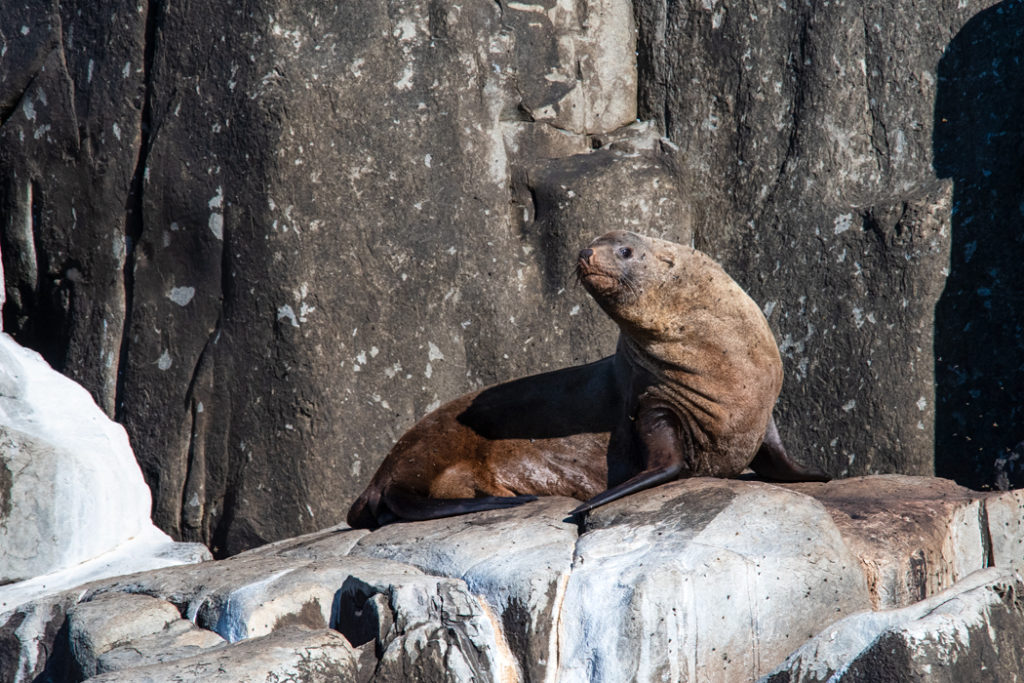
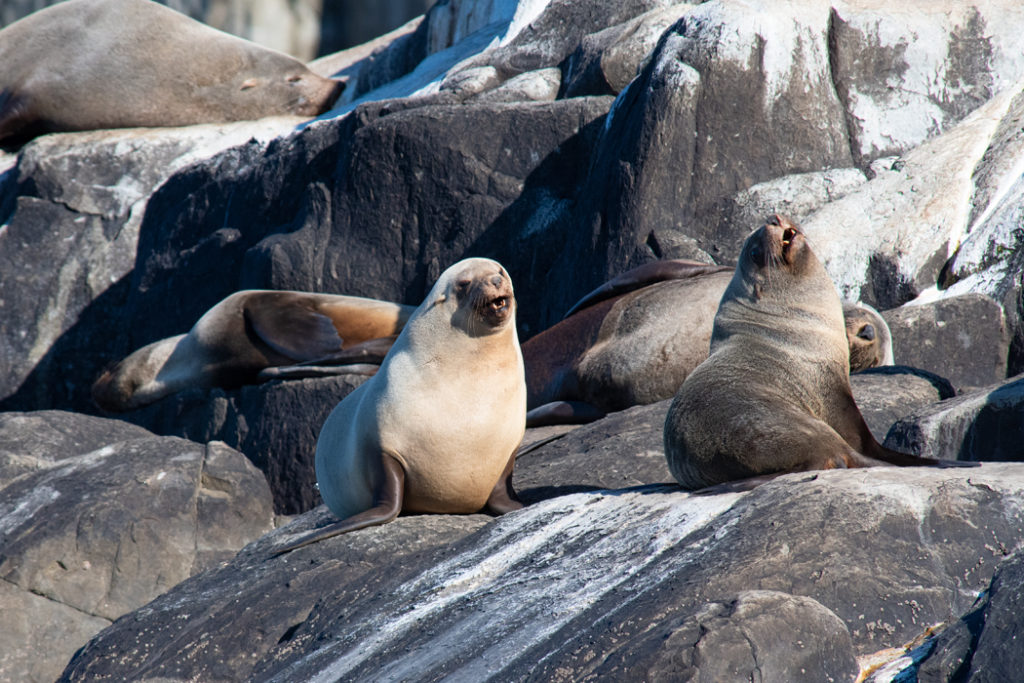
Our approach causes a little bit of a stir and the seals start to wake up from their slumber, waddle across the shore and have some arguments with each other. A couple of them hop into the water, jumping off the rocks like chubby gymnasts. But while they may appear clumsy on land, I remember how gracefull they looked underwater when we went snorkelling with them in Narooma.
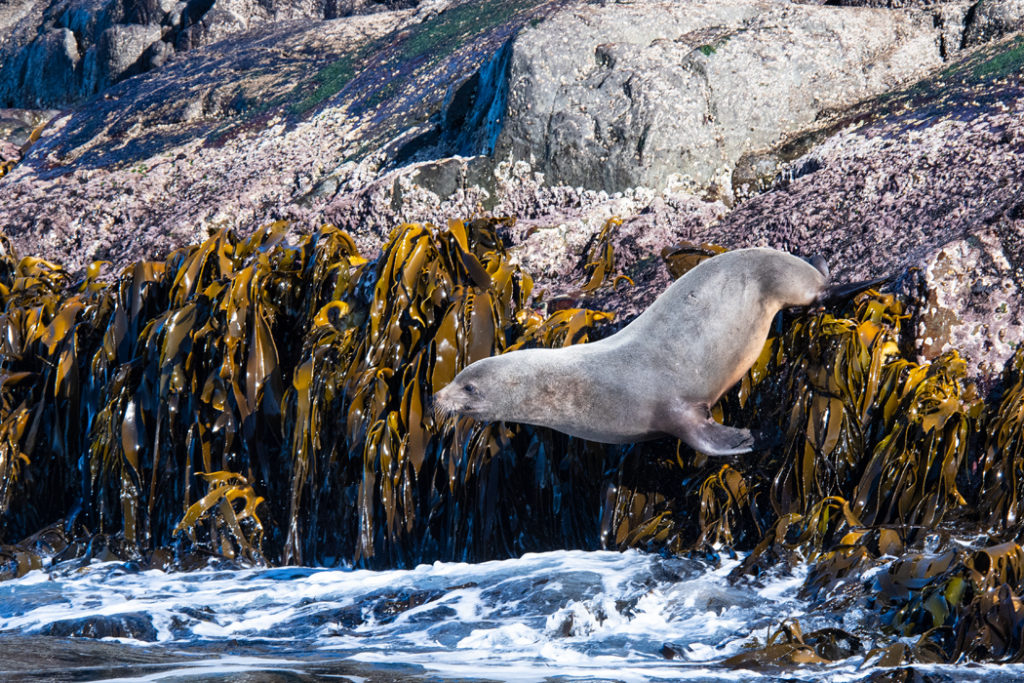
We spend some time watching them as the skipper slowly rotates the boat so that everyone can get a good look. The large rolling swells make photography from the boat super challenging, and I am grateful for more time.
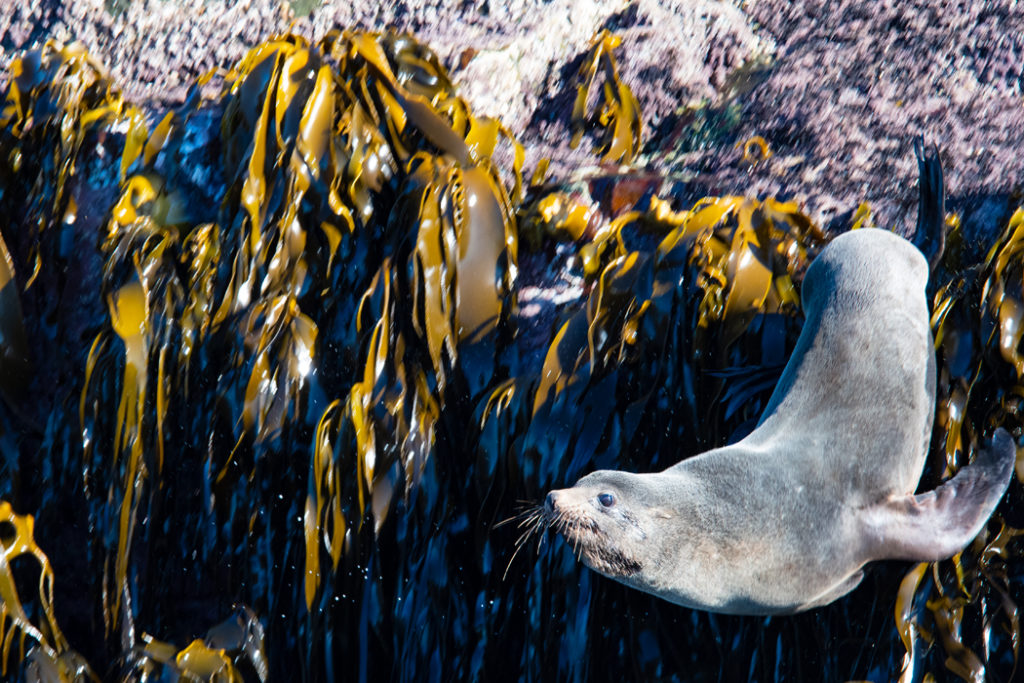
While we are checking out the seals, a White-bellied sea eagle is checking us out from above. With shearwater numbers dwindling, the predators have to work harder for their lunch.
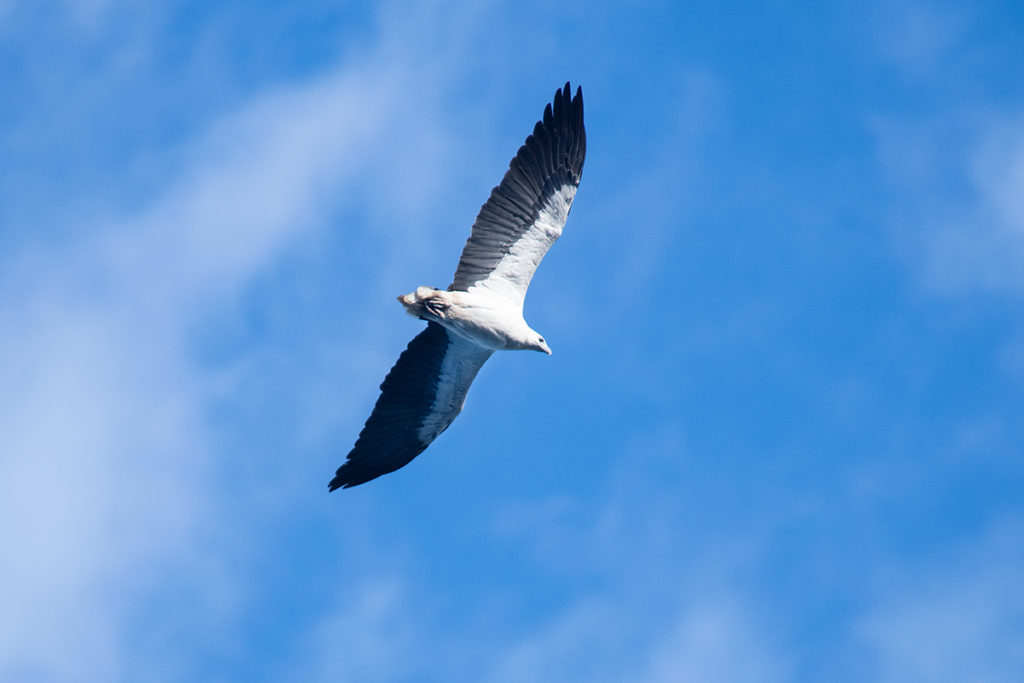
When I find myself on the ocean side, while people on the other side of the boat watch the seals, I try to take a shot of a Shy albatross. There are a few of them around, but they tend to stay further out at sea until one approaches us quite closely. I imagine that most of the boats here are fishing vessels and the birds probably learned to associate boats with fish.
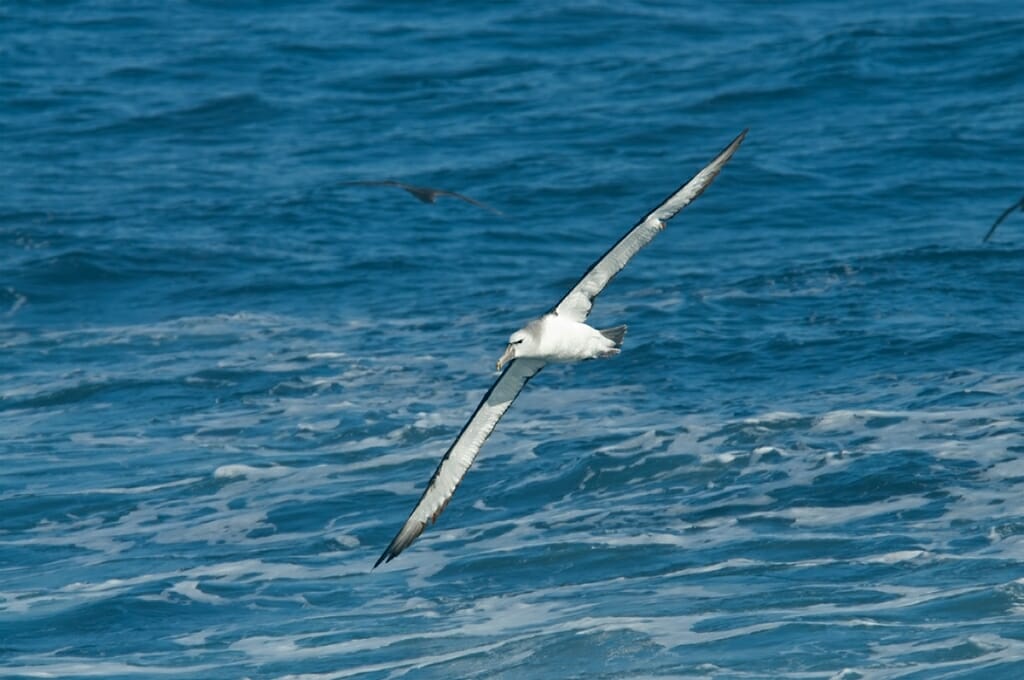
Cape Pillar
The peninsula coastline across the Tasman Passage from the Island is dominated by the impossibly high cliffs of Cape Pillar. We cruise towards a dramatic sea cave – a square-shaped opening at the bottom of the soaring sheer cliff face, like the door into the mines of Moria.
The 300-meter high hexagonal columns (the highest coastal cliffs in the Southern Hemisphere) really do make me feel like a little hobbit who stumbled into the land of giants. In comparison to these mammoth walls, the 80-meter high cliffs of my beloved Royal National Park in Sydney seem like child’s toys. To see the top of the cliff as we approach the cave, I have to crane my neck so hard, it’s starting to hurt.
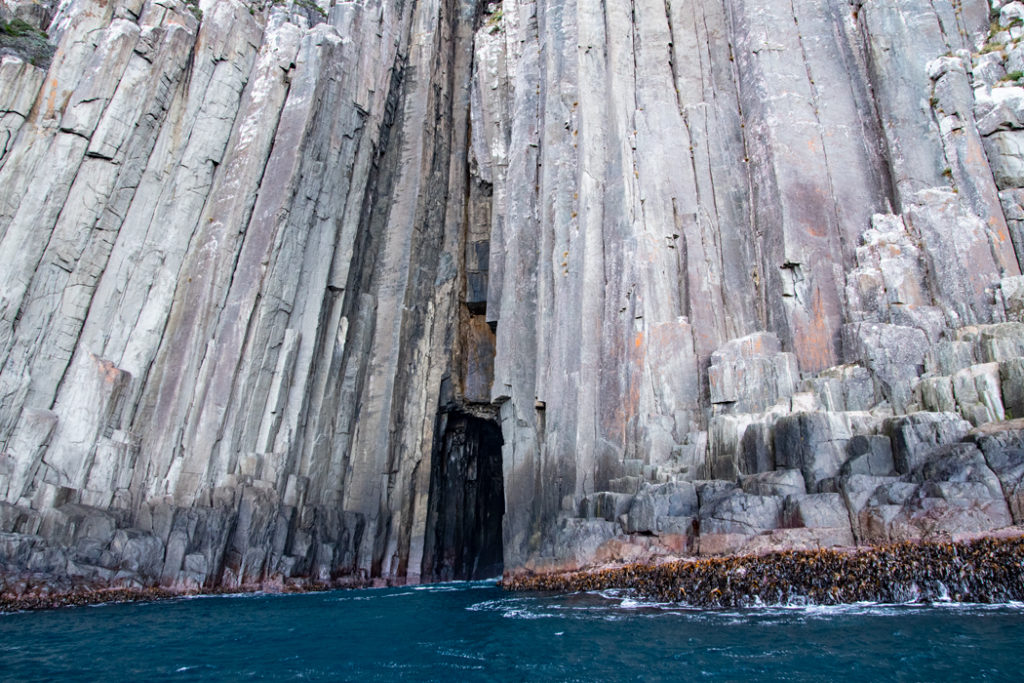
The swells that batter these cliffs are also nothing short of mammoth – the highest recorded wave was 19 meters! Today is the gentle 3-meter swell. The last time I faced 3-meter swells was during a seabird survey on Broughton island and I thought they were going to swallow us. Here, in the unforgiving Southern Ocean, they feel like child’s play.
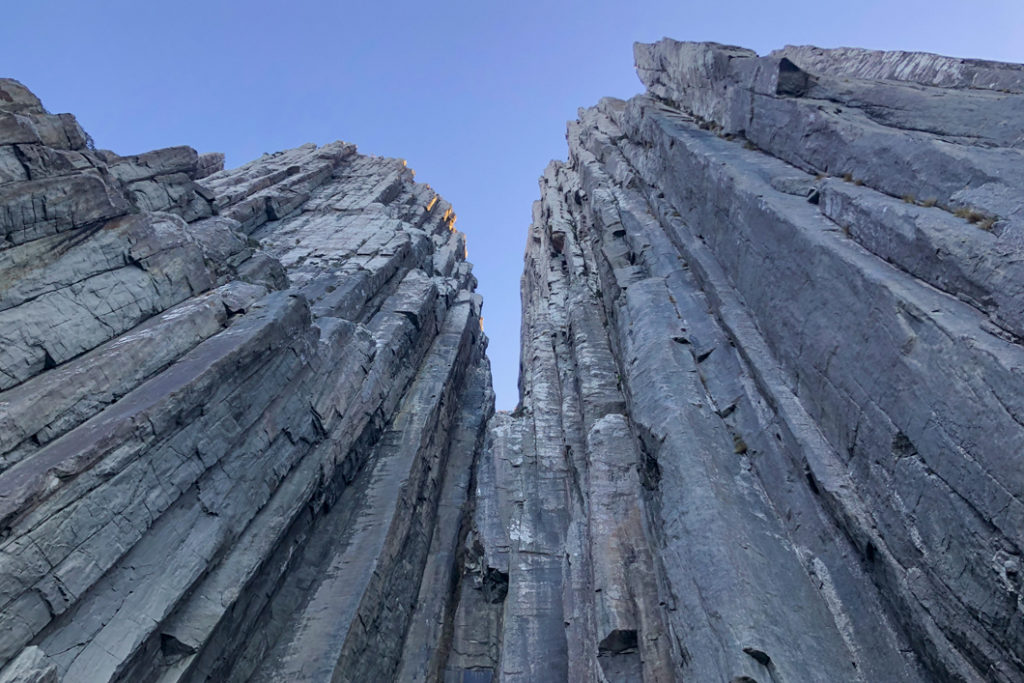
Cape Hauy
Once I see the instantly recognizable shape of the Totem Pole formation, I know we have arrived at Cape Hauy. This thin, sheer dolerite pillar is Google’s favourite image associated with the Tasman Peninsula. It is also a popular climbing challenge for hardcore rock climbers, notorious for keeping search and rescue crews busy.
Totem Pole is an amazing structure. Standing 65 meters tall and only 4 meters in diameter, it is categorized as a coastal stack, or sea stack. Erosion by the winds, the waves, and sea salt shaped it into a free standing column. And the most incredible thing about Totem Pole is that it’s still standing. Considering the constant pounding by waves at the base of the column, it should have collapsed a long time ago. And the fact that it can collapse at any time is part of its appeal to the rock climbers.
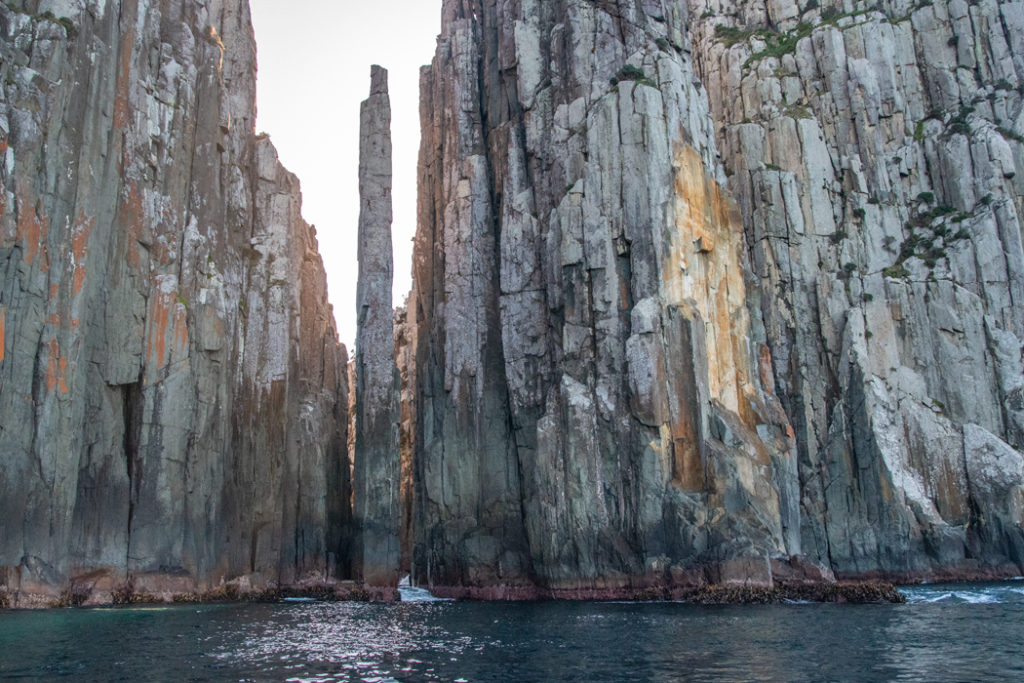
As we cruise around the cliffs surrounding Totem Pole, we spot a few more seals. Only these are much rarer and much less numerous Long-nosed fur seals. They also seem to appreciate their personal space a bit more than their Australian cousins. There are just four of them chilling out a respectful distance apart from one another.
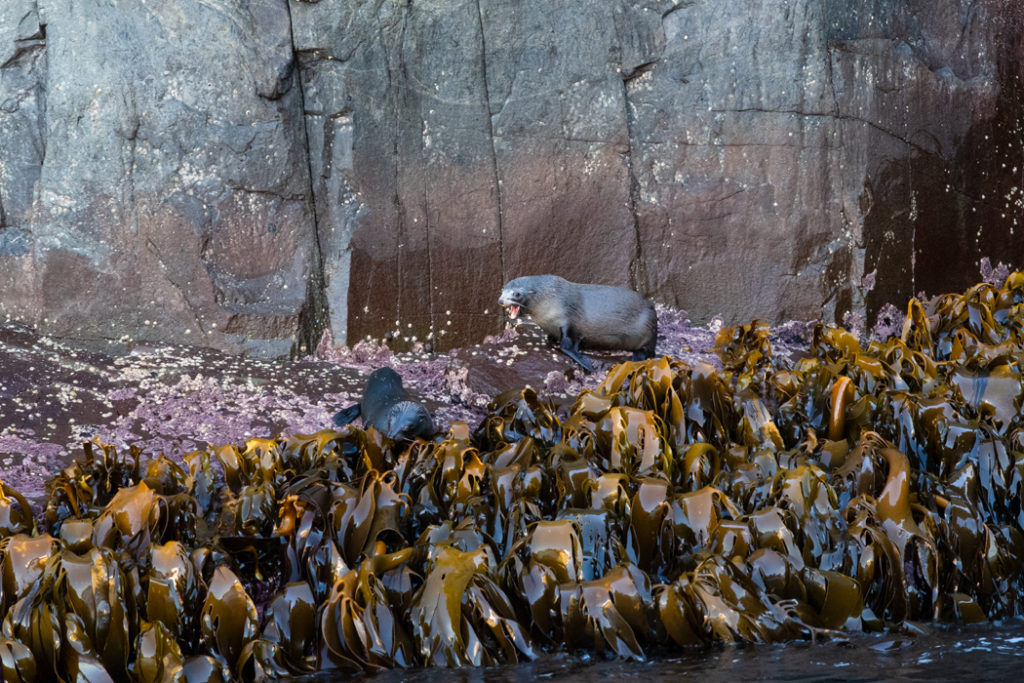
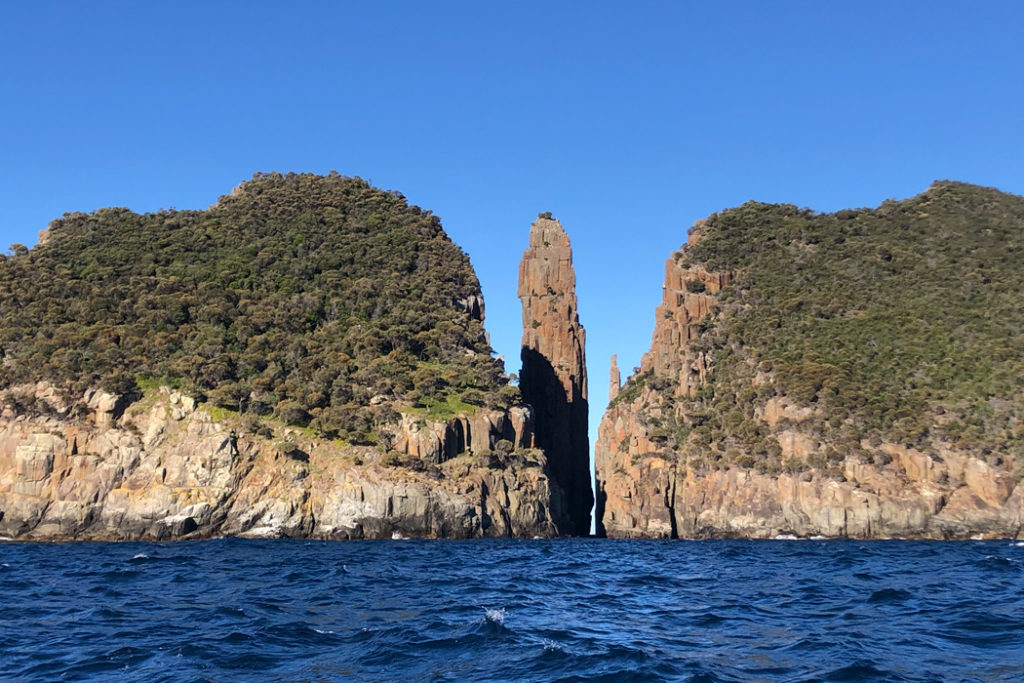
Around the headland, we are thrilled to spot the misty spray of a whale’s breath, as it wafts above the waves. It’s quite early in the Humpback migration season, but this youngster must’ve had enough of the Antarctic freeze and couldn’t wait to get to the warmer waters of the Tasman Peninsula. I can certainly relate – I am getting quite warm underneath the layers of my synthetic blubber.
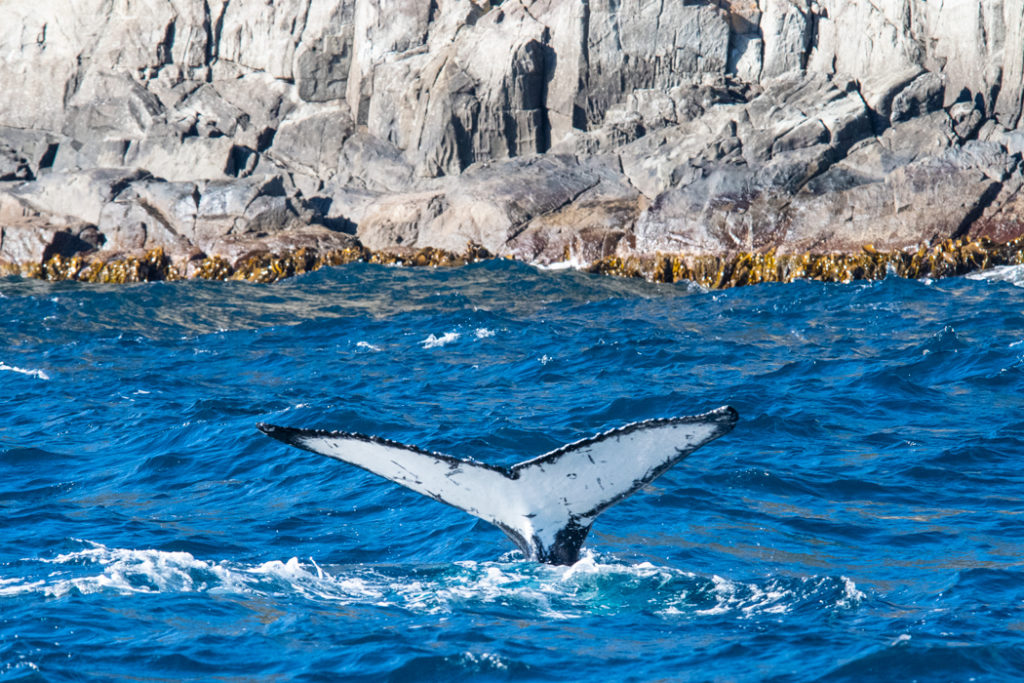
The whale stays with us for quite some time, only going for very short dives, and flicking up its tail every time it does. It rolls around in the water right next to the cliffs and waves its enormous pectoral fins at the terns and garnets flying overhead. It seems to be having a very good time.
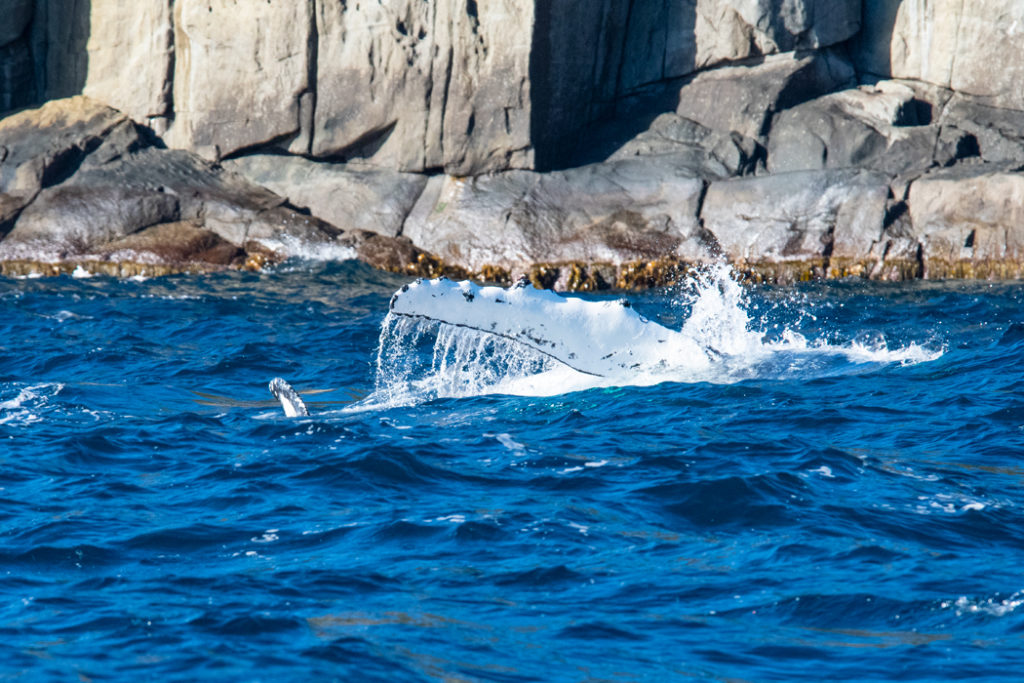
Waterfall Bay
We leave the whale on such a high note that it’s difficult to imagine that something ahead could be equally exciting. Until we arrive at a series of such extraordinary sea caves that we briefly forget about the whale. These caves are perhaps the wildest environments I’ve ever seen.
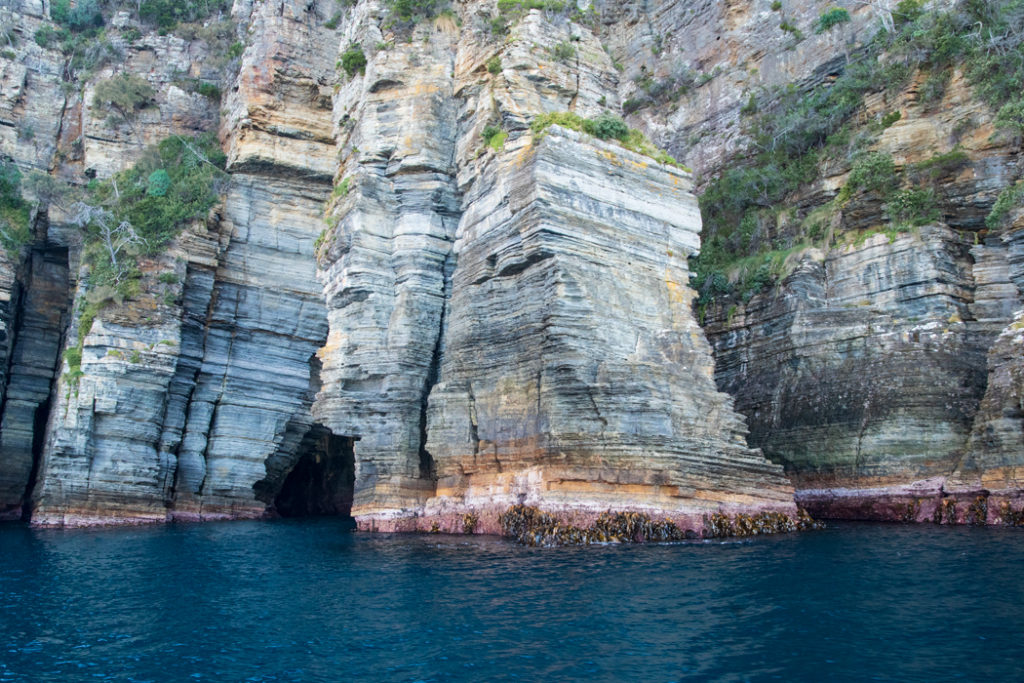
Their walls are made up of horizontal layers of sandstone that have been eroded by wi d and water into sharp-edged sheets. Dark grey above, they are bright pink at the bottom where they meet the dark turquoise waters of the ocean. They are so deep that our boat can go all the way in and not cover even half the distance. The skipper takes us into each cave and tells us about magnificent undersea caves that lay below us. In his view, this is one of the best cave diving spots in the world.
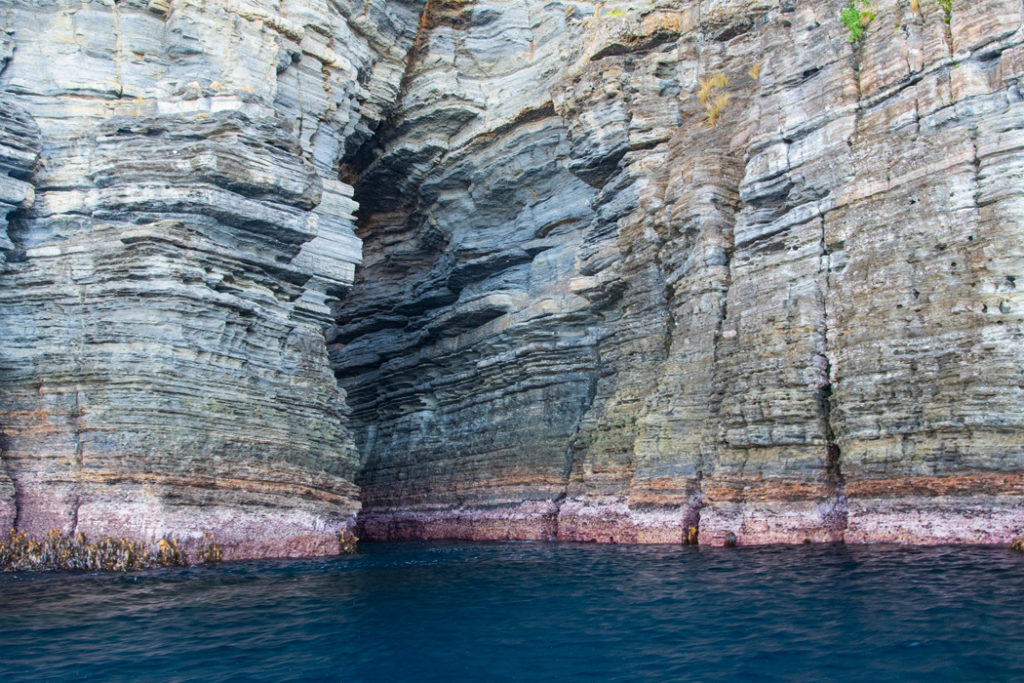
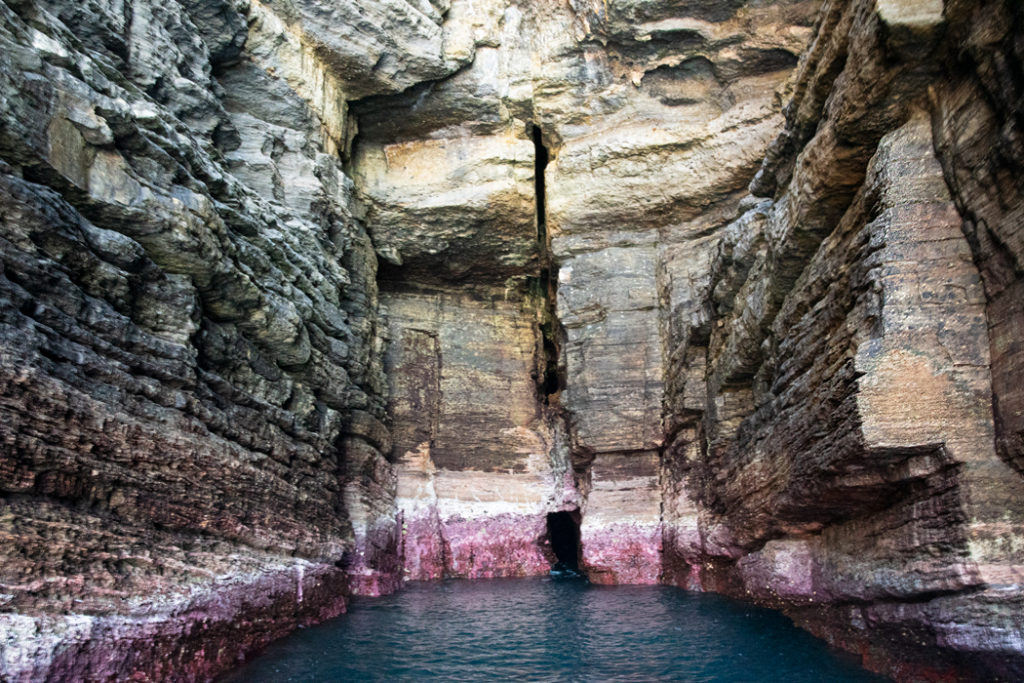
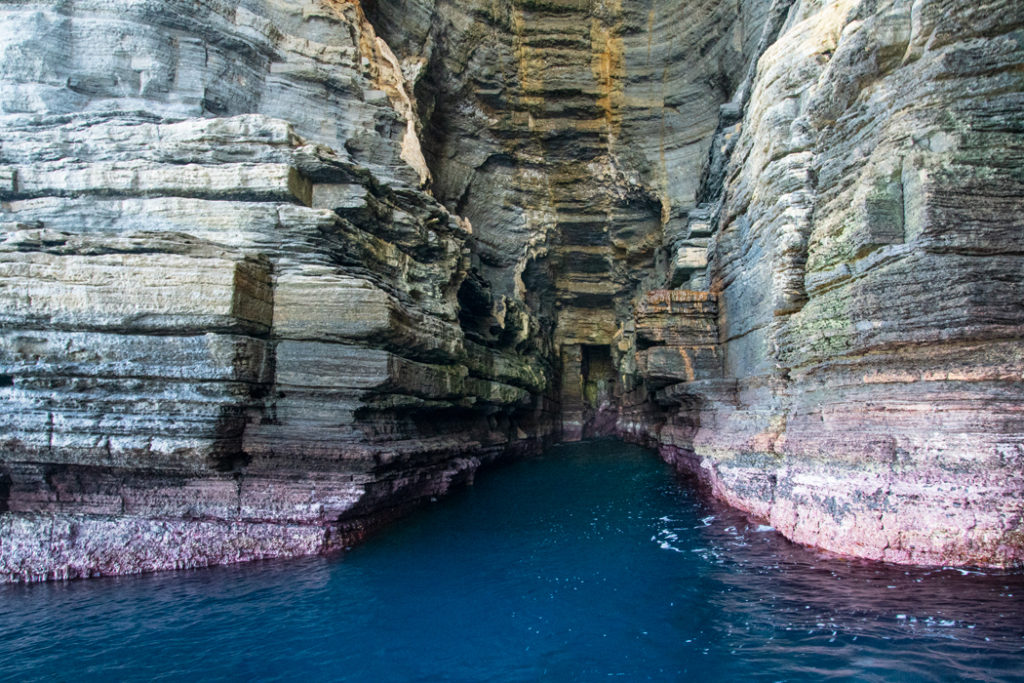
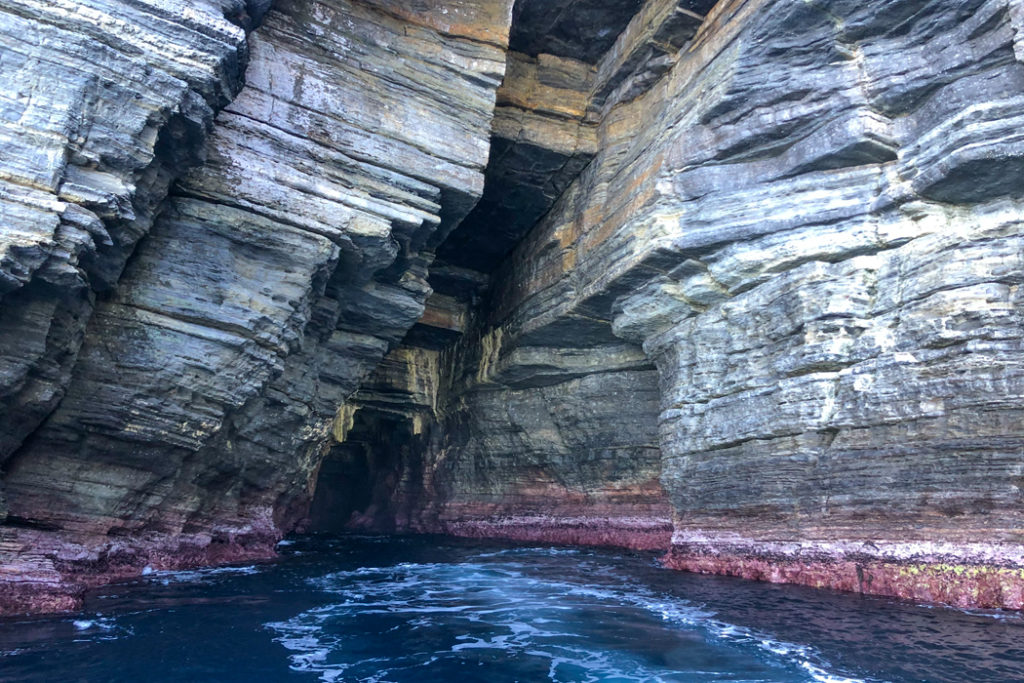
There are no waterfalls in the bay today, it’s been too dry in this part of the country for too long. It’s hard to remember that Tasmania is considered the second driest state in Australia.
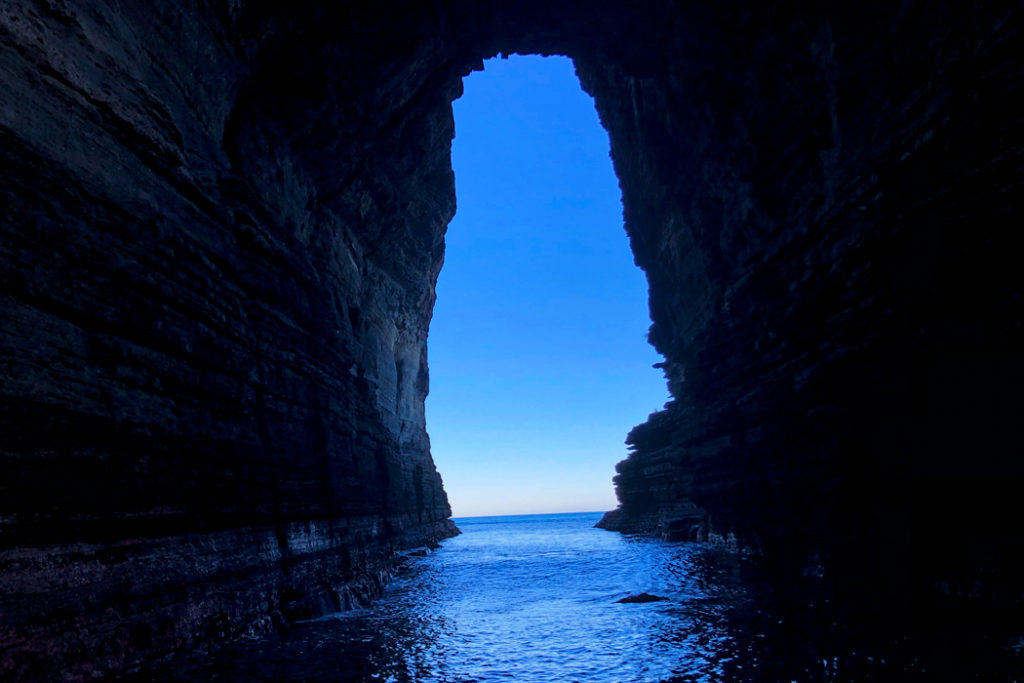
Tasman Arch
The last geological marvel we see is the Tasman arch – a towering cavern with a partially collapsed roof. What remains of the roof creates a natural bridge on top of a 200-meter cliff. By now, I feel like my capacity to feel awe has been exhausted and I mostly just stare at the colossal structure.
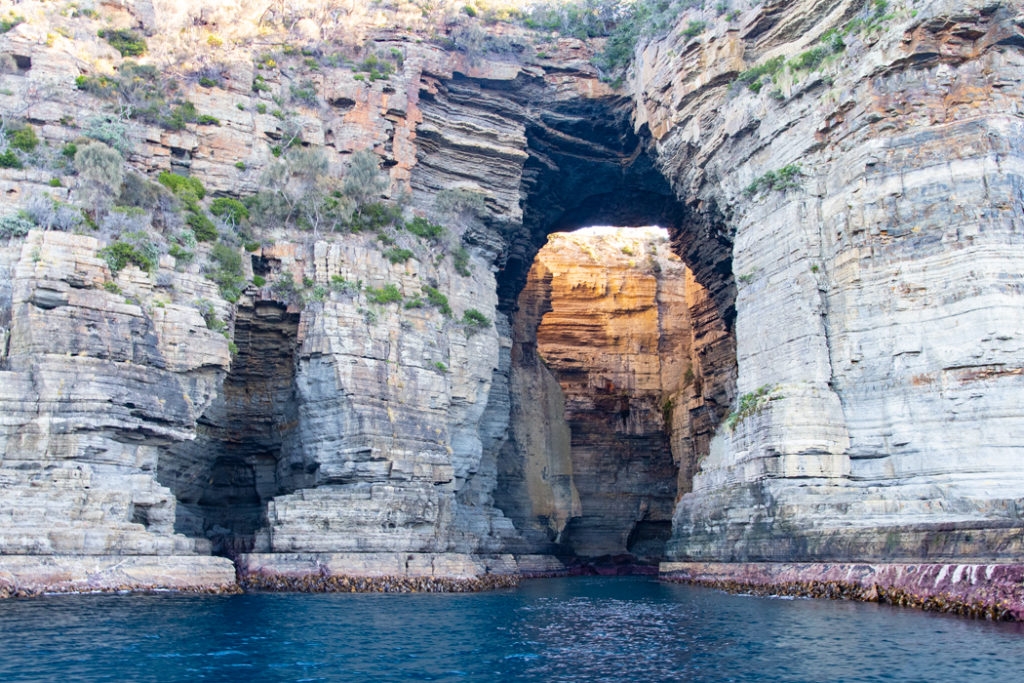
This cruise has been an incredibly engaging journey into one of the most remarkable environments on earth. The combination of the striking landscape and the abundance of wildlife makes the Tasman Peninsula a rare find for anyone who enjoys nature adventures.
The cruise ends in Pirate Bay at Eaglehawk Neck which is a small isthmus that connects the peninsula to mainland Tasmania. We drive back to Port Arthur and stop for lunch at Lavender Farm before heading out to Remarkable Cave.
Remarkable Cave
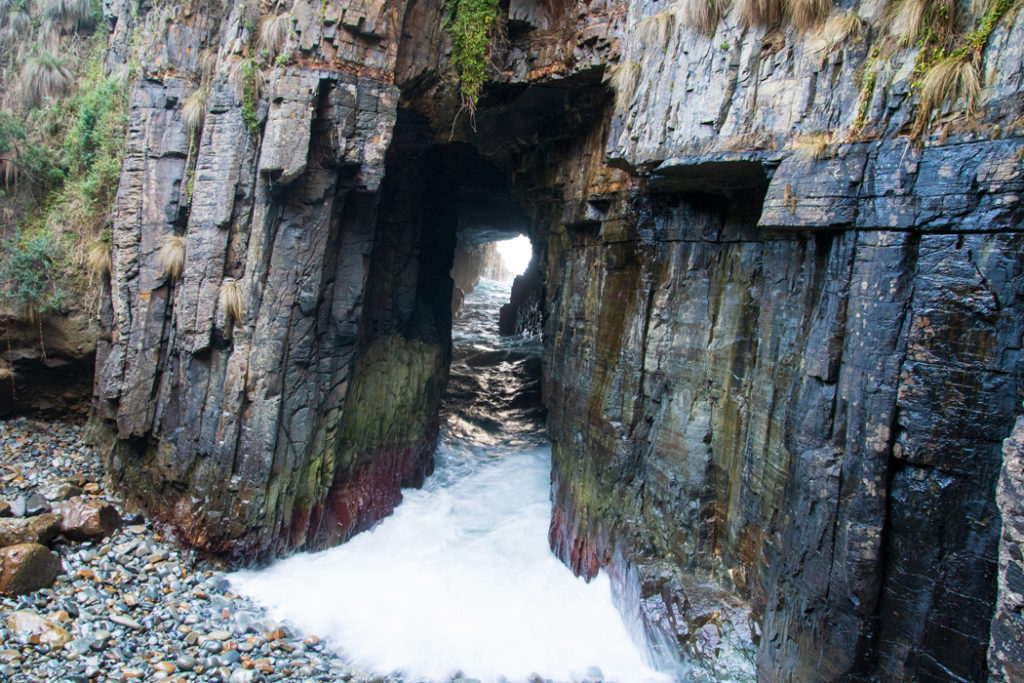
Lying just 7 km south of Port Author, Remarkable cave is a long tunnel that extends underneath the cliffs out to the ocean from the base of a collapsed gully. As the waves surge into the cave they fill the gully with water and rumbling noise.
The cave is reached by a short walk down a set of 115 steps from the Remarkable Cave car park via the rugged Penguin Rocks. The walk brings you to an elevated viewing platform at the back of the cave. The roof of the cave, that would’ve been above you, had collapsed a long time ago, its debris dragged out to sea by the waves.
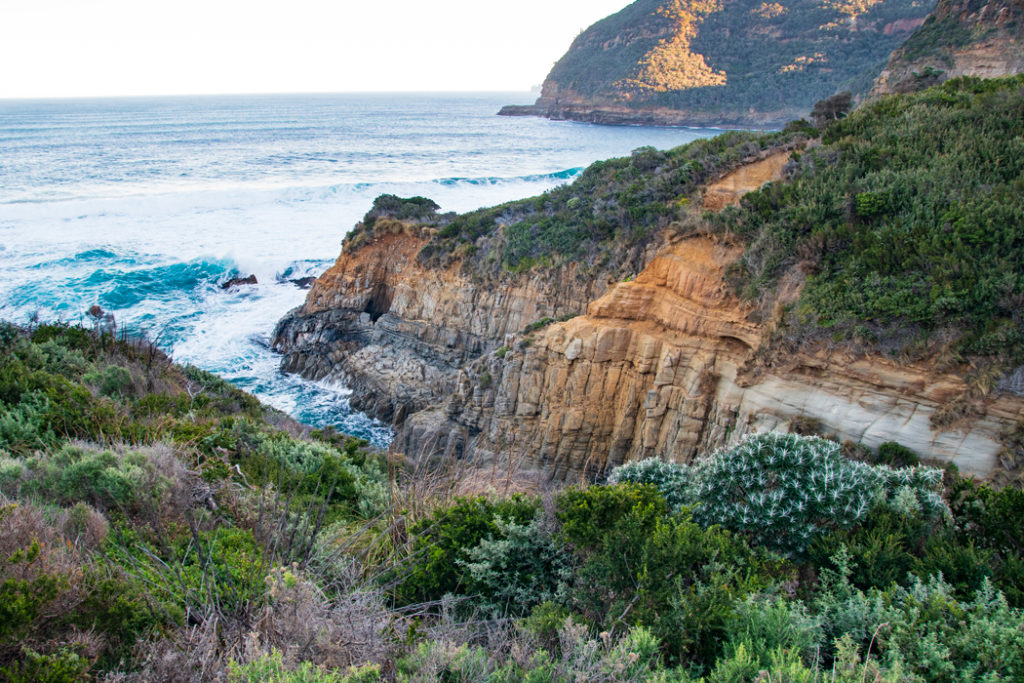
So what is so remarkable about Remarkable cave? It’s not quite the Hastings Cave in the Far South of the state. Well, for one thing, you can see the shape of Tasmania in the cave’s opening to the sea, when you stand at a certain angle.
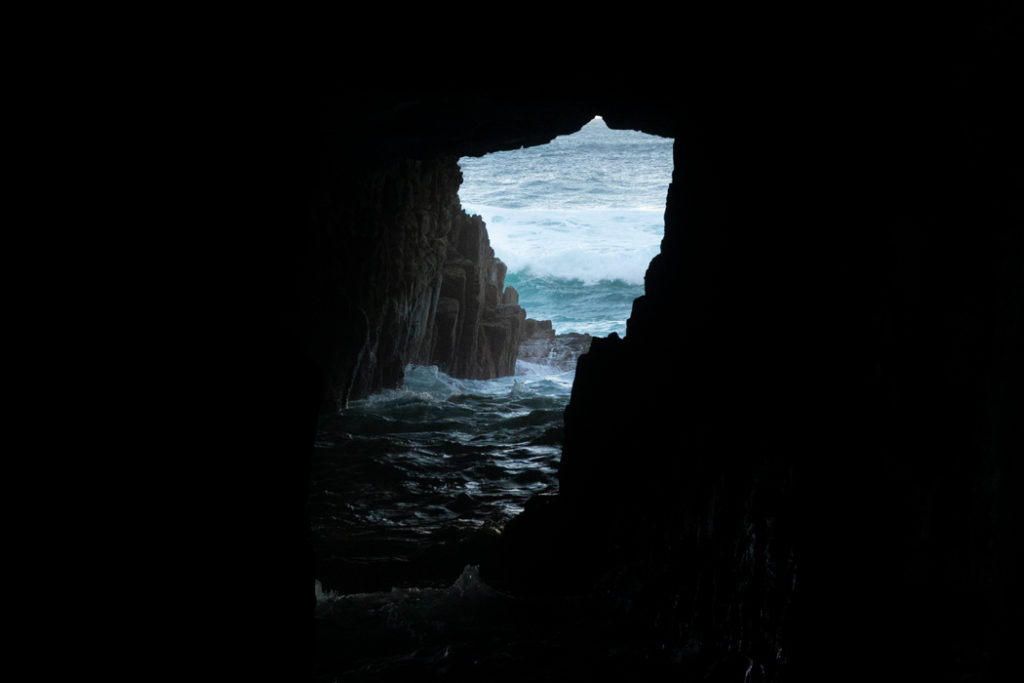
Another interesting feature of the cave is that you can see two types of rock here – sandstone that forms the horizontal layers and the vertical dolerite columns that dominate much of the Tasman Peninsular’s coastline. Dolerite was pushed up to the surface from the earth’s mantle so while it is younger rock, it is deposited underneath the sandstone.
If you are keen to stretch your legs, you can take the 9km walk to Cresent Bay, the beach with large sand dunes that we saw from the boat. The walk starts across from the car park and takes about 3.5hrs for the return journey.
Safety Cove Beach
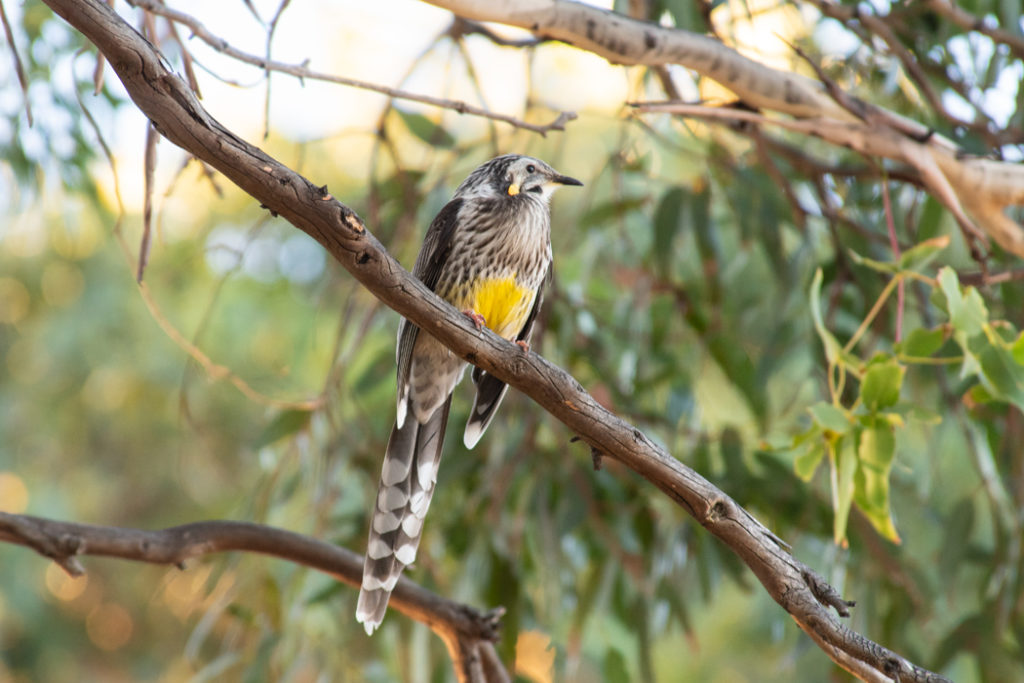
The last place we visit on the Tasman Peninsula is the tranquil Safety Cove beach. After the weather-ravaged coastline of the peninsula, this beach is an unexpected reprieve. White sand, gentle surf and whisper-like breeze. In the summer months, Safety Cove beach would be a great spot for a swim.
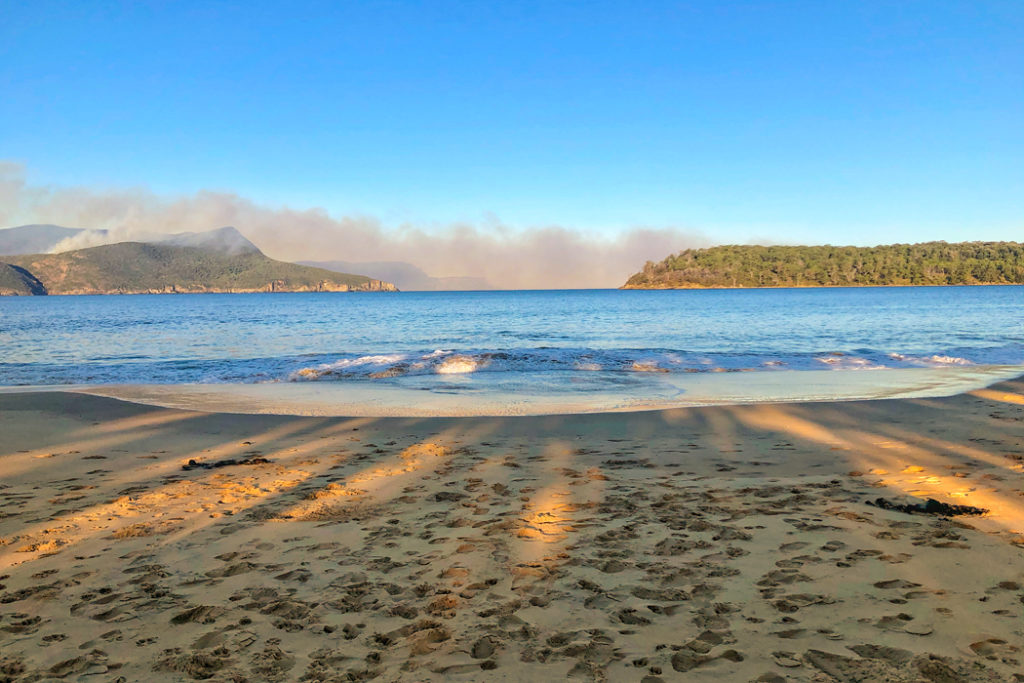
It’s late in the day and the forested shore of the beach provides a good opportunity to spot some birds: the Tasmanian endemics Yellow wattlebird, Black-headed honeyeater, Green rosella, and Black currawong, as well as Grey fantail, Superb fairy-wren and Rufous whistler.
We leave the Tasman peninsula by pretty much driving off into the sunset. This has been an extraordinary adventure and one of my most memorable experiences in Tasmania
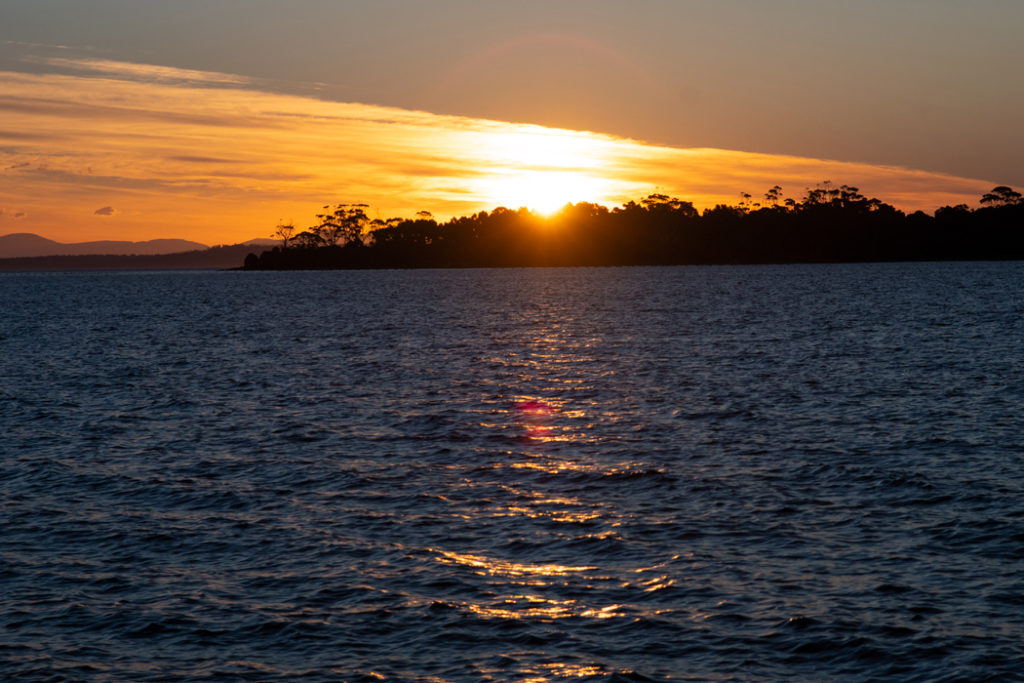
Tasman Peninsula Cruise Details
Tasman Island Cruise is a 3-hour eco-cruise operated by Pennicott Wilderness Journeys. You can either take the cruise from Port Arthur or book a full-day tour from Hobart. I joined the tour from Hobart and loved every minute of it.
.
As I planned my Southern Tasmania trip, I came across a few useful books, particularly those with suggestions on where to find wildlife and some of the best day hikes in the state. You may find some of these books handy as well.
More on Wildlife Adventures in Tasmania
- Things to do in Cradle Mountain: Walks, Wildlife & Adventure
- 10 Best Day Trips from Hobart, Tasmania
- Tarkine Drive: 2-Day Itinerary, Attractions & Accommodation
- Things to Do on Bruny Island: Guide to Itinerary Planning
- 15 Best Things to Do in Launceston: Where to Play, Eat, and Stay
- North West Tasmania Travel Guide: Iconic Highlights & Local Secrets
- Mountain Valley Wilderness Holidays Review
- Travel Guide to Edge of the World, Tasmania
- Visiting Gunns Plains Caves in North West Tasmania
- Gorgeous Beaches in Tasmania: North-West Coast

